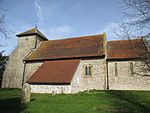Chattri, Brighton
BrightonBuildings and structures completed in 1920Grade II listed buildings in Brighton and HoveGrade II listed monuments and memorialsMilitary of British India ... and 3 more
Monuments and memorials in East SussexUse British English from September 2013World War I memorials in England

The Chattri is a war memorial in the English city of Brighton and Hove. It is sited 500 feet (150 m) above the city on the South Downs above the suburb of Patcham, and is accessible only by bridleway. It stands on the site where a number of Indian soldiers who fought for the British Empire were cremated during the First World War. The structure has Grade II listed status, reflecting its architectural and historic importance. In 2017, as part of the 100th anniversary of World War I, the site of the Chattri was dedicated as a Fields in Trust Centenary Field because of its local heritage and significance.
Excerpt from the Wikipedia article Chattri, Brighton (License: CC BY-SA 3.0, Authors, Images).Chattri, Brighton
Braypool Lane,
Geographical coordinates (GPS) Address Nearby Places Show on map
Geographical coordinates (GPS)
| Latitude | Longitude |
|---|---|
| N 50.884166666667 ° | E -0.14694444444444 ° |
Address
The Chattri
Braypool Lane
BN1 8PP , Westdene
England, United Kingdom
Open on Google Maps









